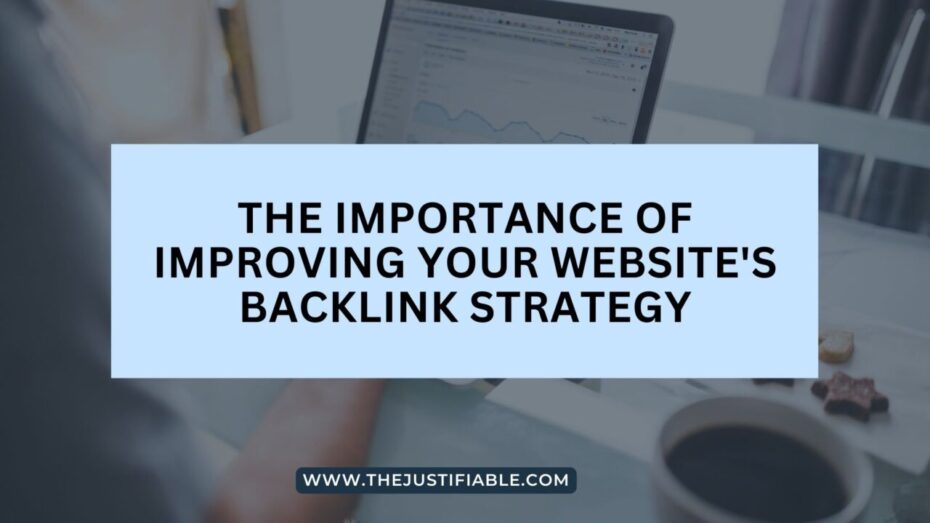Table of Contents
Enhancing your website’s backlink strategy is crucial for ensuring that it ranks highly in search engine results pages as search engines continue to develop (SERPs).
This article will go over the importance of improving your website’s backlink strategy, what makes a solid backlink strategy, and how to optimize your backlink strategy.
Why Improving Your Website’s Backlink Strategy is Essential
A strong backlink strategy can have a significant impact on your website’s search engine rankings, increasing the visibility of your website to potential customers. Backlinks are used by search engines to determine the authority and trustworthiness of a website.
Websites with a high number of quality backlinks from other reputable websites rank higher in search results than those without backlinks. Building a strong backlink profile can also help drive referral traffic to your website, increasing brand awareness and lead generation.
Backlinks as a Measure of Website Authority and Trustworthiness
Backlinks are used by search engines to determine the authority and trustworthiness of a website. A website with numerous high-quality backlinks from other reputable websites is more likely to be regarded as a reliable source of information than a website with no backlinks.
Search engines are more likely to rank the website higher in search results as a result.
The Impact of Backlinks on Referral Traffic
A strong backlink profile can drive referral traffic to your website in addition to improving search engine rankings. The traffic that comes to your website from other websites, usually as a result of a backlink, is known as referral traffic.
Referral traffic can be extremely valuable because it represents existing customers who are interested in your products or services.
What Constitutes a Strong Backlink Strategy
A strong backlink strategy focuses on obtaining high-quality backlinks from authoritative websites in your industry or niche. Backlinks from quality websites have a high domain authority, relevant content, and a natural link profile.
Low-quality backlinks, on the other hand, come from websites with low domain authority, irrelevant content, and a spammy link profile.
Building High-Quality Backlinks
Focus on creating valuable content that others will naturally want to link to in order to build high-quality backlinks. Consider contacting other websites in your industry or niche and asking them to link to your content.
Finally, take advantage of guest blogging opportunities and create infographics or other shareable content to aid in backlink generation.
Avoiding Low-Quality Backlinks
Avoiding low-quality backlinks is critical to your backlink strategy’s success. Low-quality backlinks can harm your search engine rankings and even lead to a Google penalty. It is critical to comprehend what low-quality backlinks are and how to avoid them.
Backlinks from websites that are irrelevant to your industry or niche, have a low domain authority, or use overly optimized or spammy anchor text are examples of low-quality backlinks. They can also be paid for or exchanged, which is against Google’s policies.
Focus on building links from websites that are relevant to your industry or niche to avoid low-quality backlinks. This tells Google that your website is an expert in your field. It’s also critical to prioritize link building from high-quality websites with high domain authority. These websites are usually well-known and have a large online presence.
Tips for Optimizing Your Backlink Strategy
Optimizing your backlink strategy entails monitoring your backlink profile on a regular basis, identifying and removing any low-quality backlinks, and creating new high-quality backlinks. It’s also critical to keep up with search engine algorithm changes and adjust your backlink strategy accordingly.
Monitoring and Analyzing Your Backlink Profile
Monitoring and analyzing your backlink profile is an essential component of any effective backlink strategy. You can identify spammy or low-quality links that are harming your search engine rankings by regularly monitoring your backlink profile. You can also look for opportunities to build new backlinks.
There are a number of tools available to assist you in monitoring and analyzing your backlink profile. Google Search Console is a free tool that provides detailed information about your website’s backlinks, such as the number of links, linking domains, and anchor text.
Other tools, such as Ahrefs, SEMrush, and Moz, can provide more detailed information about your backlinks, such as the linking website’s domain authority and the type of link (follow or nofollow).
When examining your backlink profile, look for any red flags that could indicate spammy or low-quality links. Links from irrelevant or low-quality websites, links with overly optimized anchor text, and links that have been paid for or exchanged are examples of this.
If you find any spammy or low-quality links, you should remove them immediately. This may entail contacting the website owner and requesting that the link be removed, or using Google Search Console’s disavow tool to instruct Google to ignore the link.
Building New High-Quality Backlinks
Create valuable content, reach out to other websites, and participate in guest blogging opportunities to build new high-quality backlinks. Consider developing linkable assets such as infographics or tools that other websites in your industry will want to link to.
Staying Up to Date with Algorithm Changes
Finally, keep up with changes to search engine algorithms and adjust your backlink strategy accordingly. Search engines’ algorithms are constantly evolving in order to provide the best results for their users.
As a result, what works today to boost search engine rankings may not work tomorrow. Staying up to date on algorithm changes and adjusting your backlink strategy accordingly can help ensure that your website’s search engine rankings remain stable over time.
Utilize Internal Linking
Internal linking is an important SEO practice that entails linking to other pages on your website. This helps to establish a clear hierarchy of content and provides search engines with a better understanding of your website’s structure. You can also keep users engaged on your website and reduce bounce rates by linking to related pages.
It is critical to have a clear strategy in place to effectively use internal linking. This entails identifying key pages on your website and linking to them from other pages that are relevant. You can also use anchor text to improve search engine rankings by indicating the relevance of the linked page.
Focus on Relevance
When creating backlinks, it is critical to prioritize relevance. Backlinks from related websites are more valuable than those from unrelated websites. This is due to the fact that a relevant backlink shows search engines that your website is an authority in your industry or niche.
To begin building relevant backlinks, identify topically relevant websites and contact them to request a link. To identify potential link building opportunities, you can also use tools like Ahrefs or SEMrush.
Diversify Your Backlink Profile
Building a diverse backlink profile is critical to ensuring that search engines do not perceive your website as spammy or manipulative. Backlinks from a variety of sources, such as blogs, news sites, directories, and social media platforms, are included in a diverse backlink profile.
Focus on building links from a variety of sources to create a diverse backlink profile. This could include guest blogging, online community participation, and reaching out to journalists and bloggers for coverage.
Focus on Quality Over Quantity
While having a large number of backlinks is important, the quality of those backlinks is even more important. A single high-quality backlink from a trustworthy website can be worth more than dozens of low-quality backlinks. Low-quality backlinks can even harm your website’s ranking in search engines.
Prioritize link building from reputable websites with high domain authority to prioritize quality over quantity. This could entail networking with other website owners in your industry and producing high-quality content that others will want to link to.
Monitor Your Competitors
Monitoring the backlink profiles of your competitors can help you identify potential link building opportunities. Look for websites that link to your competitors but not to your own, and contact them to ask for a link. You can also use tools like Ahrefs or SEMrush to find your competitors’ top backlinks and target those sites for links.






